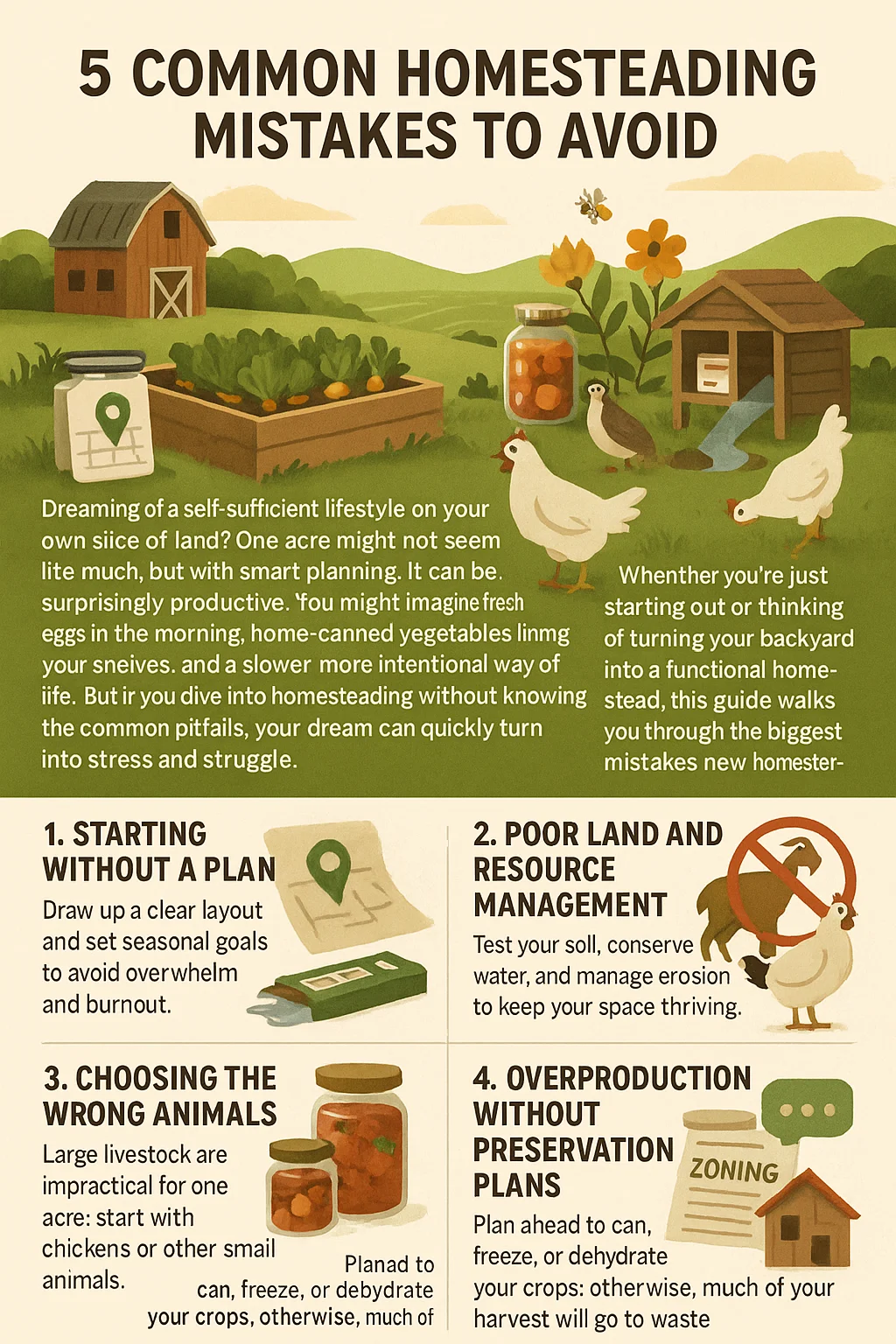Dreaming of a self-sufficient lifestyle on your own slice of land? One acre might not seem like much, but with smart planning, it can be surprisingly productive. You might imagine fresh eggs in the morning, home-canned vegetables lining your shelves, and a slower, more intentional way of life. But if you dive into homesteading without knowing the common pitfalls, your dream can quickly turn into stress and struggle. Whether you’re just starting out or thinking of turning your backyard into a functional homestead, this guide walks you through the biggest mistakes new homesteaders make—and how you can avoid them.

What Is One Acre Homesteading?

Homesteading on one acre is all about making the most of limited space to create a self-reliant lifestyle. From growing your own food to raising small livestock and preserving your harvest, one acre can offer a surprising level of productivity when used wisely.
One acre is 43,560 square feet. That’s enough to grow a large garden, raise chickens or rabbits, keep bees, compost, store tools, and even build a small greenhouse. The key is intentional design and avoiding the temptation to overdo everything at once.
Is One Acre Enough for a Homestead?
Yes—if you plan realistically. With proper layout and management, your acre can provide:
- Seasonal fruits and vegetables
- Protein from small animals or eggs
- Pollination from bees
- Compost from kitchen scraps and manure
Just remember: it’s not about producing everything, but enough to reduce your dependency on grocery stores and build food security.
Mistake #1: Starting Without a Plan
Jumping into one acre homesteading without a clear strategy is a recipe for burnout. Many beginners fall into the trap of doing too much too soon—chickens, goats, a 10-bed garden, fruit trees—all at once. The result? Overwhelm, exhaustion, and often, failure.
How to Avoid It:
- Map your space. Allocate specific areas for garden beds, animal pens, water access, storage, and composting.
- Set seasonal goals. For example, start with just chickens and one raised bed in year one.
- Track your progress. Keep a journal to note what works and what needs adjusting.
- Think long-term. What can be added gradually over 3–5 years?
Mistake #2: Poor Land and Resource Management
You may not think of one acre as needing land management, but it absolutely does. Mismanaging your soil and water can sabotage your homesteading efforts before they begin.
Common Issues:
- Planting without testing your soil
- Letting runoff erode garden beds
- Overusing water with inefficient systems
Smart Fixes:
- Get a basic soil test kit or contact your local agricultural extension office.
- Design garden beds with swales or mulch to control water flow.
- Invest in a rainwater catchment system to reduce utility bills.
- Use drip irrigation and mulch to conserve moisture.
👉 Want a complete guide that teaches you how to manage your land, grow your own food, preserve your harvest, and even collect rainwater off-grid?
Check out The Self-Sufficient Backyard to learn how to turn your one acre into a productive homestead.
Mistake #3: Choosing the Wrong Animals
You might be tempted to buy goats, pigs, or even a cow for your homestead, but that’s rarely practical on just one acre. Large animals consume too much space, feed, and time.
Best Livestock for One Acre Homesteading:
- Chickens – Great for eggs, pest control, and composting help
- Rabbits – High yield of meat in a small footprint
- Quail – Require less space and produce eggs and meat
- Bees – Pollination + honey with minimal land use
| Animal | Space Needed | Benefits | Challenges |
|---|---|---|---|
| Chickens | ~10 sq ft per bird | Eggs, manure, insect control | Predator protection needed |
| Rabbits | Very small | Quiet, efficient meat source | Heat sensitive |
| Bees | Minimal | Pollination, honey | Special care and licensing |
Avoid: Large livestock unless you have additional acreage or resources.
Mistake #4: Overproduction Without Preservation Plans
It’s easy to get excited about growing food—but what happens when your tomatoes ripen all at once? Without a system to preserve what you produce, you’ll waste a lot of food, time, and effort.
How to Preserve Your Harvest:
- Canning: Tomatoes, jams, pickles, soups
- Freezing: Greens, fruits, broth
- Dehydrating: Herbs, apples, tomatoes
- Root Cellaring: Potatoes, squash, carrots
Example Canning Recipes:
| Recipe | Ingredients | Jar Size | Processing Time |
| Tomato Sauce | Tomatoes, lemon juice, garlic | Quart | 40 mins (WB) |
| Strawberry Jam | Strawberries, sugar, lemon juice | Half-pint | 10 mins (WB) |
Plan preservation before you grow to reduce waste.
Mistake #5: Ignoring Legalities and Local Community
Many first-time homesteaders assume they can do whatever they want on their land. Not true. Local ordinances often restrict livestock, fencing, structures, and even water usage.
Avoid Legal Headaches:
- Check your city or county zoning laws
- Get permits for fences, coops, or sheds
- Research HOA rules if applicable
Don’t Forget Community:
- Join local homesteading Facebook groups or co-ops
- Visit farmer’s markets and connect with other growers
- Attend workshops hosted by extension services or libraries
🛠️ Recommended Resource: The Self-Sufficient Backyard
If you’re serious about building a self-sufficient life—even on a small plot—this resource is a game changer.
What You’ll Learn:
-
Off-grid food, water, and energy systems
-
Year-round gardening strategies
-
Long-term food preservation (root cellars, canning, drying)
-
Chickens, compost, and sustainable waste management
Whether you’re just starting out or ready to scale, The Self-Sufficient Backyard offers a blueprint for making your land work harder and smarter—for decades to come.
Pro Tips for One Acre Homesteading Success
Want to fast-track your progress? These habits separate thriving homesteaders from the ones who quit in frustration:
![" Act as an experienced SEO copywriter, tasked with writing a [article length ] words long article based on the provided [outline]. Your primary goal is to craft a compelling, informative piece that not only adheres to SEO best practices but also ranks high on search engines for the chosen keywords. Use an informative Tone of voice and make sure to use a Point of view for the Second person (you, your, yours), Enhances readability of the article and bypasses AI detection by not using known words and sentences used by Ai detectors. The article should be well-researched, engaging to the target audience, and structured in a way that enhances readability (using headings, subheadings, bullet points, etc.). Incorporate relevant keywords naturally throughout the text, without compromising the flow or quality of the content. Ensure that the article answers the questions or solves the problems outlined, providing value to the reader. permaculture on one acre](http://successformulalab.com/wp-content/uploads/2025/05/permaculture-on-one-acre-scaled.webp)
- Use permaculture zones to design your layout efficiently
- Rotate crops and animals to maintain soil health
- Compost everything—waste becomes fertilizer
- Set reminders for planting, harvesting, and maintenance
- Record everything in a seasonal log or planner
- Be realistic about what you can handle solo vs. with help
Frequently Asked Questions About One Acre Homesteading
Can you really be self-sufficient on one acre?
Yes, partly. While full independence is tough, you can produce the majority of your vegetables, eggs, and some meat with careful planning.
What animals are best for a small homestead?
Start with chickens or rabbits. Both offer high returns with little space and cost.
What are the best crops for small-scale homesteading?
Tomatoes, greens, beans, herbs, and root vegetables are all compact and high-yield.
How much time does one acre homesteading require?
Expect to spend 10–20 hours a week, depending on season and systems in place. The more efficient your setup, the less maintenance needed.
Do I need experience to start homesteading?
Not at all! Start small, learn as you go, and don’t be afraid to fail and adapt.
Final Thoughts: Build a Homestead That Lasts
One acre homesteading is a rewarding path to independence—but only if you approach it with clarity, patience, and purpose. Avoiding beginner mistakes like overcommitting, skipping soil prep, and ignoring preservation will help you build a resilient, abundant lifestyle.
Start with what feels manageable. Learn your land. Get to know your food, your animals, and your limits. Over time, that single acre can provide not just nourishment—but peace, fulfillment, and a deep connection to the land.
🌱 Ready to take control of your homestead dream?
Start building with The Self-Sufficient Backyard now—your step-by-step guide to living more freely, with less.

